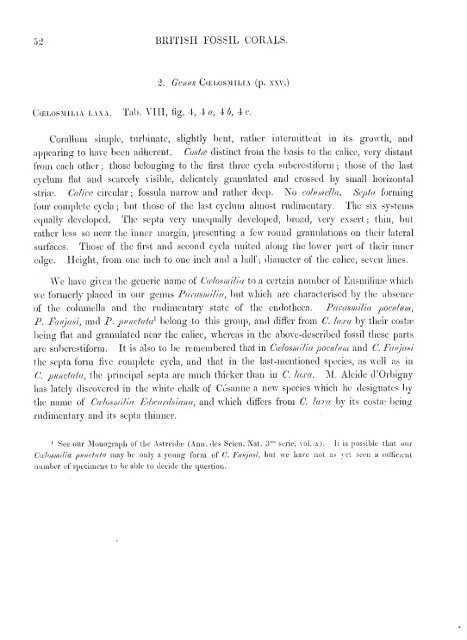A monograph of the British fossil corals - kreidefossilien.de
A monograph of the British fossil corals - kreidefossilien.de
A monograph of the British fossil corals - kreidefossilien.de
Create successful ePaper yourself
Turn your PDF publications into a flip-book with our unique Google optimized e-Paper software.
53 BRITISH FOSSIL CORALS.<br />
2. Genus Ccelosmilia (p. xxv.)<br />
C(ELOSMiLiA LAXA. Tab. VIII, fig. 4, 4 a, 4 ^, 4 c.<br />
CoraUum simple, turbinate, slightly bent, ra<strong>the</strong>r intermittent in its- growth, and<br />
appearing to have been adherent.<br />
Costa distinct from <strong>the</strong> basis to <strong>the</strong> cahce, very distant<br />
from each o<strong>the</strong>r ; those belonging to <strong>the</strong> fu-st three cycla subcrestiform ; those <strong>of</strong> <strong>the</strong> last<br />
cycluni flat and scarcely visible, <strong>de</strong>licately granulated and crossed by small horizontal<br />
striae. Calice cii'cular; fossula narrow and ra<strong>the</strong>r <strong>de</strong>ep. No columella. Septa forming<br />
fom' complete cycla ; but those <strong>of</strong> <strong>the</strong> last cyclum almost rudimentary. The six systems<br />
equally <strong>de</strong>veloped. The septa very unequally <strong>de</strong>veloped, broad, very exsert ; thin, but<br />
ra<strong>the</strong>r less so near <strong>the</strong> inner margin, presenting a few round granulations on <strong>the</strong>ir lateral<br />
surfaces. Those <strong>of</strong> <strong>the</strong> first and second cycla united along <strong>the</strong> lower part <strong>of</strong> <strong>the</strong>ir inner<br />
edge. Height, from one inch to one inch and a half ; diameter <strong>of</strong> <strong>the</strong> calice, seven lines.<br />
We have given <strong>the</strong> generic name <strong>of</strong> Ccelosmilia to a certain number <strong>of</strong> Eusmilinee which<br />
we formerly placed in our genus Parasmilia, but which are characterised by <strong>the</strong> absence<br />
<strong>of</strong> <strong>the</strong> columella and <strong>the</strong> rudimentary state <strong>of</strong> <strong>the</strong> endo<strong>the</strong>ca. Parasmilia poctilum,<br />
P. Faifjasi, and P. punctata^ belong to this group, and differ from C. laxa by <strong>the</strong>ir costse<br />
being flat and granulated near <strong>the</strong> calice, whereas in <strong>the</strong> above-<strong>de</strong>scribed <strong>fossil</strong> <strong>the</strong>se parts<br />
are subcrestiform. It is also to be remembered that in Coelosmilia ])oculum and C.Faujasi<br />
<strong>the</strong> septa form five complete cycla, and that in <strong>the</strong> last-mentioned species, as well as in<br />
C. punctata, <strong>the</strong> principal septa are much thicker than in C. laxa. M. Alci<strong>de</strong> d'Orbigny<br />
has lately discovered in <strong>the</strong> white chalk <strong>of</strong> Cesanne a new species which he <strong>de</strong>signates by<br />
<strong>the</strong> name <strong>of</strong> Ccelosmilia Edwardsiana, and which differs from C. laxa by its costse being<br />
rudimentary and its<br />
septa thinner.<br />
1 See our Monograph <strong>of</strong> <strong>the</strong> Astrei<strong>de</strong>e (Ann. <strong>de</strong>s Scien. Nat. 3'°' serie, vol. x). It is possible that our<br />
Coslosmilia punctata may be only a young form <strong>of</strong> C. Favjasi, but we have not as yet seen a sutRcieut<br />
number <strong>of</strong> specimens to be able to <strong>de</strong>ci<strong>de</strong> <strong>the</strong> question.
















